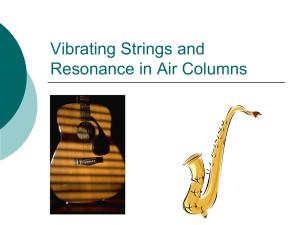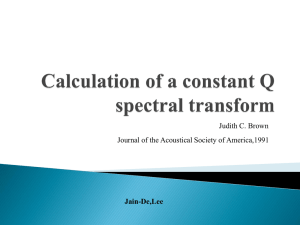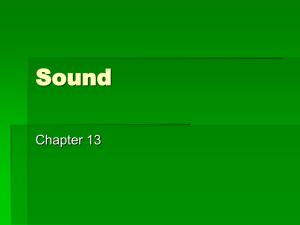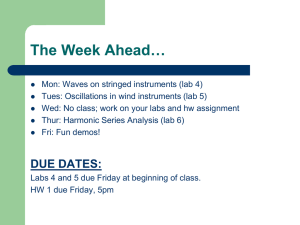H10e_IM_21 - University of South Alabama
advertisement
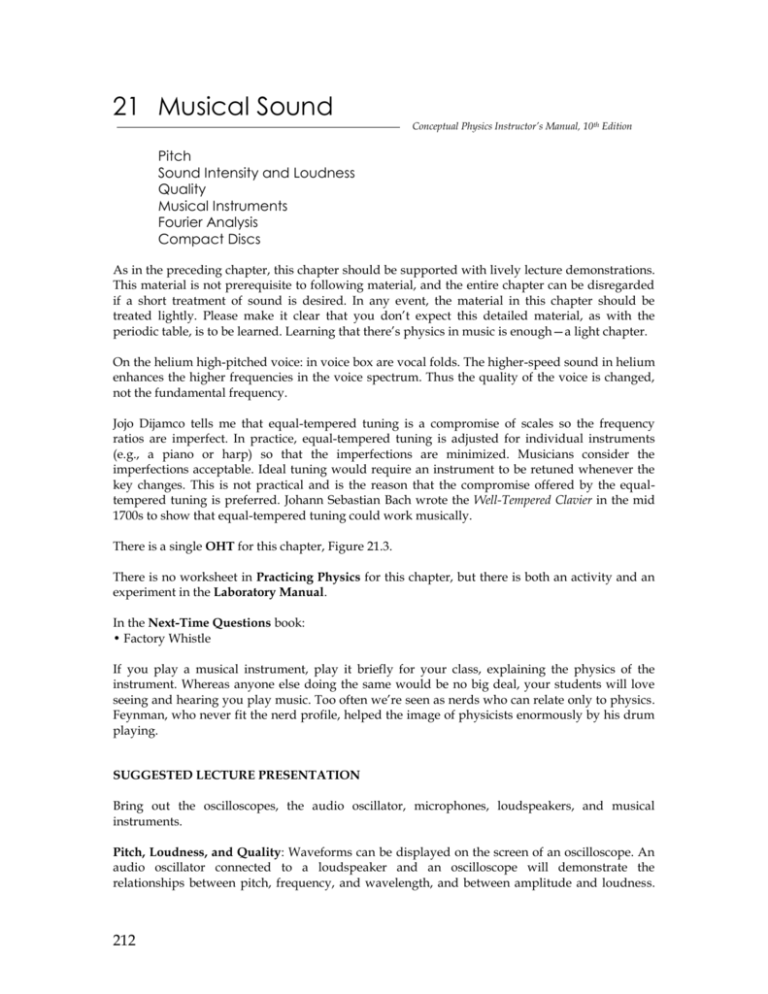
21 Musical Sound Conceptual Physics Instructor’s Manual, 10th Edition Pitch Sound Intensity and Loudness Quality Musical Instruments Fourier Analysis Compact Discs As in the preceding chapter, this chapter should be supported with lively lecture demonstrations. This material is not prerequisite to following material, and the entire chapter can be disregarded if a short treatment of sound is desired. In any event, the material in this chapter should be treated lightly. Please make it clear that you don’t expect this detailed material, as with the periodic table, is to be learned. Learning that there’s physics in music is enough—a light chapter. On the helium high-pitched voice: in voice box are vocal folds. The higher-speed sound in helium enhances the higher frequencies in the voice spectrum. Thus the quality of the voice is changed, not the fundamental frequency. Jojo Dijamco tells me that equal-tempered tuning is a compromise of scales so the frequency ratios are imperfect. In practice, equal-tempered tuning is adjusted for individual instruments (e.g., a piano or harp) so that the imperfections are minimized. Musicians consider the imperfections acceptable. Ideal tuning would require an instrument to be retuned whenever the key changes. This is not practical and is the reason that the compromise offered by the equaltempered tuning is preferred. Johann Sebastian Bach wrote the Well-Tempered Clavier in the mid 1700s to show that equal-tempered tuning could work musically. There is a single OHT for this chapter, Figure 21.3. There is no worksheet in Practicing Physics for this chapter, but there is both an activity and an experiment in the Laboratory Manual. In the Next-Time Questions book: • Factory Whistle If you play a musical instrument, play it briefly for your class, explaining the physics of the instrument. Whereas anyone else doing the same would be no big deal, your students will love seeing and hearing you play music. Too often we’re seen as nerds who can relate only to physics. Feynman, who never fit the nerd profile, helped the image of physicists enormously by his drum playing. SUGGESTED LECTURE PRESENTATION Bring out the oscilloscopes, the audio oscillator, microphones, loudspeakers, and musical instruments. Pitch, Loudness, and Quality: Waveforms can be displayed on the screen of an oscilloscope. An audio oscillator connected to a loudspeaker and an oscilloscope will demonstrate the relationships between pitch, frequency, and wavelength, and between amplitude and loudness. 212 You can speak into the loudspeaker and display a wave pattern on the oscilloscope screen, showing that the loudspeaker serves as a microphone. (It may or may not be appropriate to briefly discuss the electromagnetic induction that takes place in the electromagnet of the loudspeaker at this point.) The waveforms of various musical instruments can be displayed and compared on the oscilloscope screen. Show the different harmonics for the same notes played on different instruments. Discuss quality. If you display a decibel meter, show that for mid-range frequencies a decibel is the just-noticeable sound level difference that humans can detect. Demonstrate Chladni figures with a fastened metal plate, violin bow, and fine sand. Or show the Ealing Film Loop of the same (if you have any of those still around). Discuss nodes and antinodes. Musical Instruments: Although standing longitudinal waves are not treated in the text, you may wish to introduce this topic and relate it to musical instruments. If so, begin by demonstrating the resonance of standing air columns with a resonance water tube (a long glass tube partially filled with water, the level of which can be adjusted by raising or lowering an external reservoir). Hold a vibrating tuning fork over the open tube and adjust the water level until the air in the tube resonates loudly to the sound being sent into it by the fork. Show and explain that several heights will result in resonance. Measure the wavelengths of a high and a low frequency sound. Consider doing as Paul Hickman does and drop a couple of Alka-Seltzer tablets into the water. The air column above soon is filled with CO2 and the tone of the reverberating sound undergoes a marked change. Relate the relative sizes of the respective sound cavities to the relative sizes of musical instruments; the bigness of a bass fiddle, and the smallness of a piccolo. These ideas underlie the tones one produces when blowing over the top of a soda pop bottle. If you demonstrate resonance with the standard tube of water, consider a non-water alternative. Do as James Warden does and use a short piece of dowel that just slips in a vertical tube and suspend it with a string. Position the tuning fork at the bottom of the pipe instead of at the top. Since the sliding node can be moved much more quickly and accurately than a water column, you or your students can locate resonances within a few seconds. (Page 308, The Physics Teacher, May 2005.) Fourier Analysis: You may want to discuss Fourier Analysis and the superposition of waves and show on the chalkboard how the composite wave in Figure 21.10 is a sum of the fundamental and the second and third harmonics. The Practice Page on wave superposition for the previous chapter goes nicely with this chapter, for it is reinforced by Figure 21.10. Ask your class how many grooves there are on a typical record. (Remember them?) [The answer is one!] CDs: Discuss the operation of a compact disc. 213 Solutions to Chapter 21 Exercises 1. Agree, for pitch is the subjective form of frequency. 2. Frequency increases also, for pitch is the subjective form of frequency. 3. The sound of commercials is concentrated at frequencies to which the ear is most sensitive. Whereas the overall sound meets regulations, our ears perceive the sound as distinctly louder. 4 . F o r t h e h i g h e s t f r e q u e n c i e s , wa ve l e n g t h = v / f = ( 3 4 0 m / s ) / ( 2 0 , 0 0 0 H z) = 0.017 m or 17 mm. For the lowest frequencies, wavelength = v/f = (340 m/s)/(20 Hz) = 17 m. 5. A low pitch will be produced when a guitar string is (a) lengthened, (b) loosened so that tension is reduced, and (c) made more massive, usually by windings of wire around the string. That’s why bass strings are thick—more inertia. 6. The strings warm up and expand during play. Hence they should be tuned while warm so re-tuning is minimized while on stage. 7. Amplitude. 8. Pitch depends on frequency. It does not depend on loudness or quality. 9. The length of a flute is crucial to the notes it plays. Expansion or contraction of the flute with temperature can change its pitch, and therefore change the tuning between the instruments. 10. The frequencies of the sound and the oscillating string are the same. 11. Less tension means less frequency and lower-pitched sound. 12. Strings are depressed with the fingers to change the length of vibrating parts. 13. If the wavelength of a vibrating string is reduced, such as by pressing it with your finger against the neck of a guitar, the frequency of the vibration increases. This is heard as an increased pitch. 14. The wavelength is the length of two loops, 60 cm. 15. The longer tines have greater rotational inertia, which means they’ll be more resistant to vibrating, and will do so at lower frequency. Similarly, a long pendulum has greater rotational inertia and swings to and fro at a slower pace. 16. The greater mass increases the inertia of the string which decreases the frequency at which it will vibrate. 17. The thicker string has more mass and more inertia, and therefore a lower frequency. 18. The sounding board of the guitar presents more area of vibration, which produces louder sound. With no sounding board on the work bench, the sound is not as loud. 214 19. A plucked guitar string would vibrate for a longer time without a sounding board because less air is set into motion per unit of time, which means the energy of the vibrating string decreases more slowly. 20. The fundamental for a string occurs when only two nodes exist; one at each end of the string, so that it vibrates in one segment. By touching the midpoint, a third node is imposed there and the string vibrates in two segments. The wavelength is diminished by one-half, so the frequency increases by two. (This is because the speed of the wave along the string doesn’t change; speed = frequency wavelength.) 21. In addition to pieces of paper at the supporting ends of the string, when a string vibrates in two segments a piece may be placed at the node in its center. For three segments, two pieces can be supported, each one third the total distance from each end. 22. Period = 1/f = 1/440 second (0.002 second or 2 ms). 23. Period = 1/f = 1/264 second (0.004 second or 4 ms). 24. Both produce different quality and different over and undertones. 25. The amplitude in a sound wave corresponds to the overpressure of the compression or equivalently the under pressure of the rarefaction. 26. The pattern shown to the left has the higher frequency and therefore the higher pitch. 27. The pattern on the right has the greater amplitude and is therefore louder. 28. The loudness of the sound depends mainly on the amplitude of oscillation of the diaphragm. For a given diaphragm (but not in comparing one diaphragm with another), it depends on the kinetic energy of the diaphragm. It may also depend on the frequency in the sense that the human ear has different sensitivity to different frequencies (for instance, if the frequency is high enough, you don’t hear the sound at all). 29. The range of human hearing is so wide that no single mechanical audio speaker can faithfully reproduce all the frequencies we can hear. So hi-fi speakers divide the range into two (and three) parts. A speaker with a relatively large surface has more inertia and is not as responsive to higher frequencies as a speaker with a smaller surface. So the larger speaker pushes the longer wavelengths, or lower frequencies, and the smaller speaker pushes the shorter wavelengths, or higher frequencies. (Ideally, the diameter of the speaker should be 1/2 the wavelength of a given sound—so a 12-inch speaker corresponds to about 550 hertz—and even larger speakers are best for bass notes.) 30. Sound intensity is a purely objective and physical attribute of a sound wave and can be measured by various acoustical instruments. Loudness, though closely related, is a physiological sensation, and can vary from person to person or for one person at different times. 31. The person with the more acute hearing is the one who can hear the faintest sounds —the one who can hear 5 dB. 32. Sound at 40 dB is 10 thousand times more intense (each additive increment of 10 dB corresponds to a factor 10 in intensity). 215 33. S o u n d a t 1 1 0 d B i s a m i l l i o n t i m e s m o r e i n t e n s e t h a n s o u n d a t 5 0 d B . Th e d i f f e r e n c e , 6 0 dB, corresponds to 106, a million. 34. An electronic organ produces the sounds of various musical instruments by duplicating and superimposing the sine waves that make up the overall waves produced by these instruments. 35. Helium molecules and oxygen molecules at the same temperature have the same kinetic energies. Kinetic energy equals 1/2 mv2. The smaller mass of helium is compensated for by a greater speed (Chapter 17). 36. Your voice sounds fuller in a shower principally because of the small enclosure that causes your voice to reverberate as it reflects from wall to wall. 37. The limited range of frequencies transmitted by a telephone can’t match the full range in music. Especially, it cuts off the higher-frequency overtones of music that contribute to its quality. 38. The range of human hearing, from about 20 Hz to about 20,000 Hz, is a factor of about 1000. This is ten octaves because ten doublings of frequency gives a factor of approximately 1000 (1024 to be exact). The range of a piano is a little more than seven octaves. 39. The second harmonic has twice the frequency, 524 Hz. 40. Frequency of second harmonic is twice the fundamental, or 440 Hz. The third is three times the harmonic, or 660 Hz. 41. The first harmonic is the fundamental, which is the same 440 Hz. The second harmonic is twice this, 880 Hz. The third harmonic is three times the first, 3 440 = 1320 Hz. 42. Not including endpoints, there are 5 nodes in a wave two wavelengths long, and 7 nodes in a wave three wavelengths long. (Make a drawing and count them!) 43. When the piano string is struck it will oscillate not only in its fundamental mode of 220 Hz when tuned, but also in its second harmonic at 440 Hz. If the string is out of tune, this second harmonic will beat against the 440 Hz tuning fork. You tune the string by listening for those beats and then either tightening or loosening the string until the beating disappears. 44. Although the speed of sound past a listener on a windy day will change, the wavelength will correspondingly change also, resulting in no change in frequency or pitch. Or look at it this way: suppose a friend is placing bottles on a conveyor belt, say at a “frequency” of one each second. Then you, at the other end of the belt, take off one bottle each second. Now suppose your friend increases the speed of the belt, but still puts on one bottle each second. Can you see that the bottles (farther apart now) will still arrive to you at the rate of one per second? 45. By controlling how hard he blows and how he holds his mouth, the bugler can stimulate different harmonics. The notes you hear from a bugle are actually harmonics; you don’t hear the fundamental. 46. A Fourier analyzer is a device that sorts out the individual sine waves from a mixture of two or more sine waves, which is just what the human ear does. You hear the pure tones that make up a complex tone. 47. Blue light is higher-frequency light, with shorter waves that allow closer spacing of the pits. 48. We each perceive what we have been taught or have learned to perceive. This applies to our appreciation of art, our taste for food, and drink, and to the value we give to that which we smell, and to the textures we touch. Our perception of what is real in terms of religious beliefs, political beliefs, and our notions about where we fit in the scheme of things, is a product of what we have learned (or have not learned). 49. The likelihood is high that you subject yourself to louder sounds than your grandparents experienced—particularly via earphones. 50. Open-ended. 216 Chapter 21 Problem Solutions 1. The decibel scale is based upon powers of 10. The ear responds to sound intensity in logarithmic fashion. Each time the intensity of sound is made 10 times larger, the intensity level in decibels increases by 10 units. So a sound of (a) 10 dB is ten times more intense than the threshold of hearing. (b) 30 dB is one thousand times more intense than the threshold of hearing. (c) 60 dB is one million times more intense than the threshold of hearing. 2. A sound of 40 dB is ten times as intense as a sound of 30 dB. 3. One octave above 1000 Hz is 2000 Hz, and two octaves above 1000 Hz is 4000 Hz. One octave below 1000 Hz is 500 Hz, and two octaves below 100 Hz is 250 Hz. 4. The second harmonic is the first octave (twice the fundamental frequency) and the fourth harmonic is the second octave (four times the fundamental frequency), so there is one harmonic, the third, between the first and second octaves. The second octave, with a frequency four times the frequency of the fundamental, is the same as the eighth harmonic, so there are three harmonics (the fifth, sixth, and seventh) between the second and third octaves. (You can also get the answers by thinking about wavelengths. The second harmonic has half the wavelength of the fundamental, the third harmonic has one-third the wavelength, the fifth harmonic has one-fifth the wavelength, and so on. The wavelengths of the octaves are one-half, one-fourth, one-eighth, and so on, so they correspond to the second, fourth, eighth, and so on harmonics.) 5. The wavelength of the fundamental is twice the length of the string, or 1.5 m. Then the speed of the wave is v = f= 220 Hz 1.5 m = 330 m/s. (Note that this is for a transverse vibration of the string. A longitudinal sound-wave within the string could have a much greater speed.) 217
